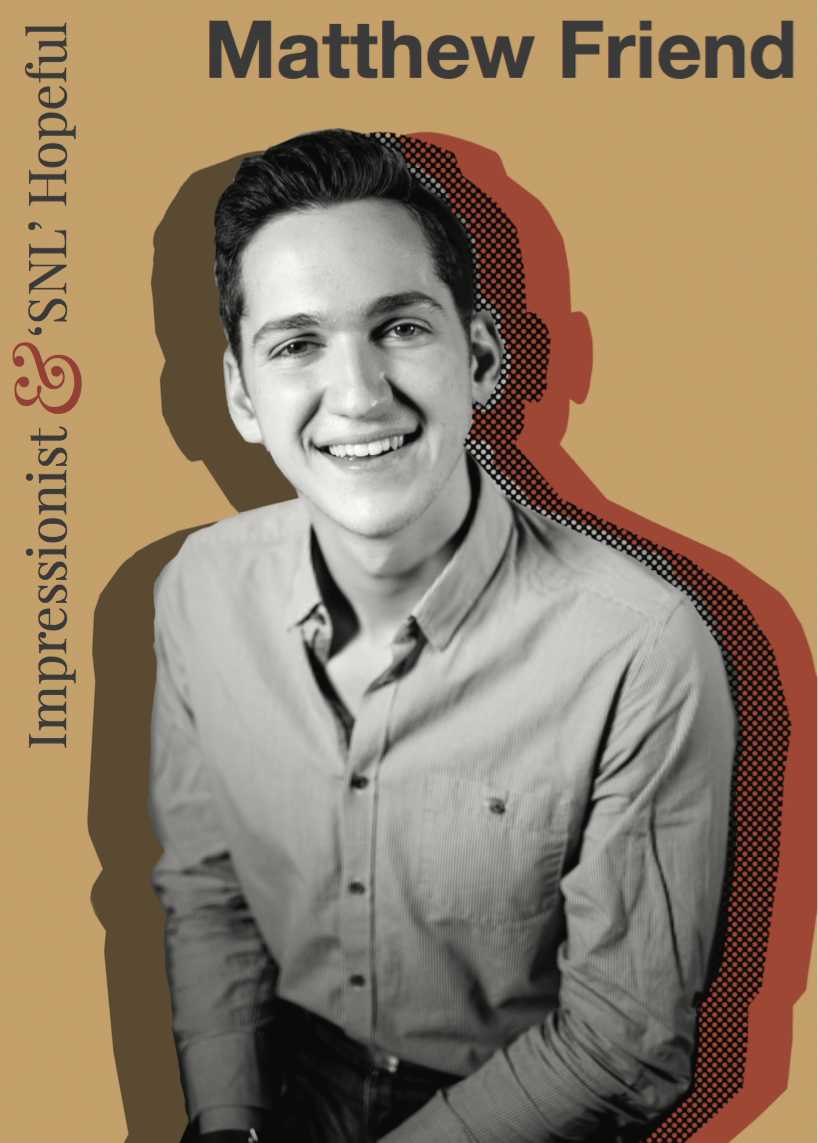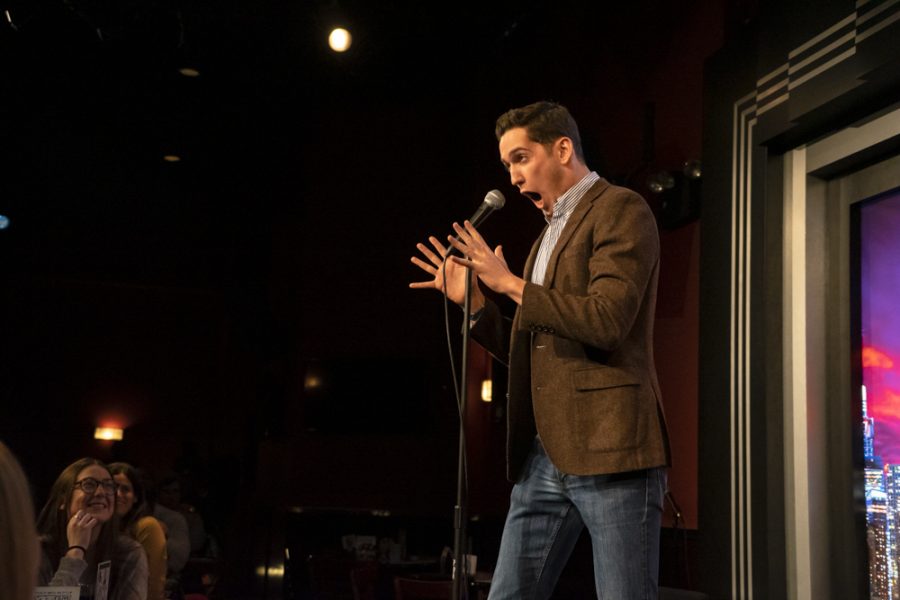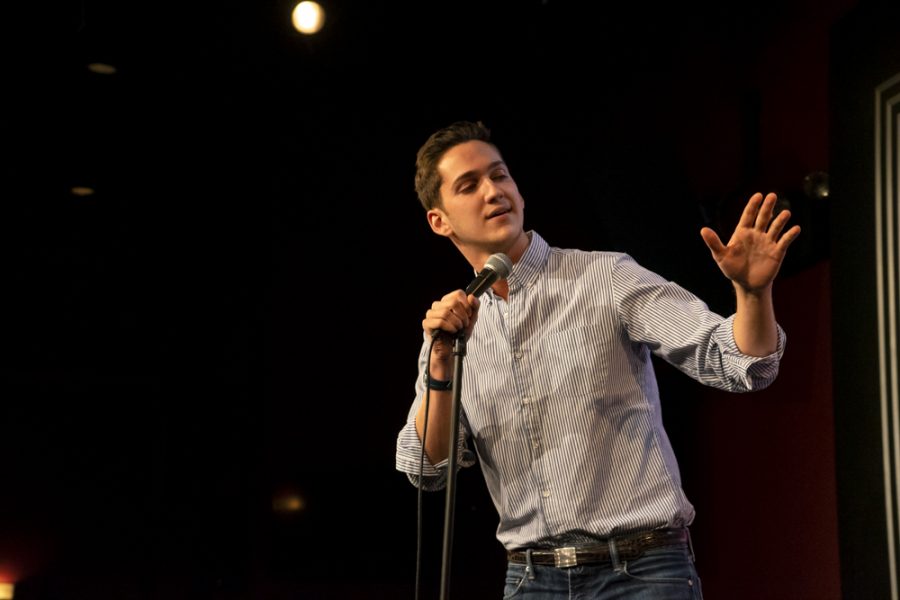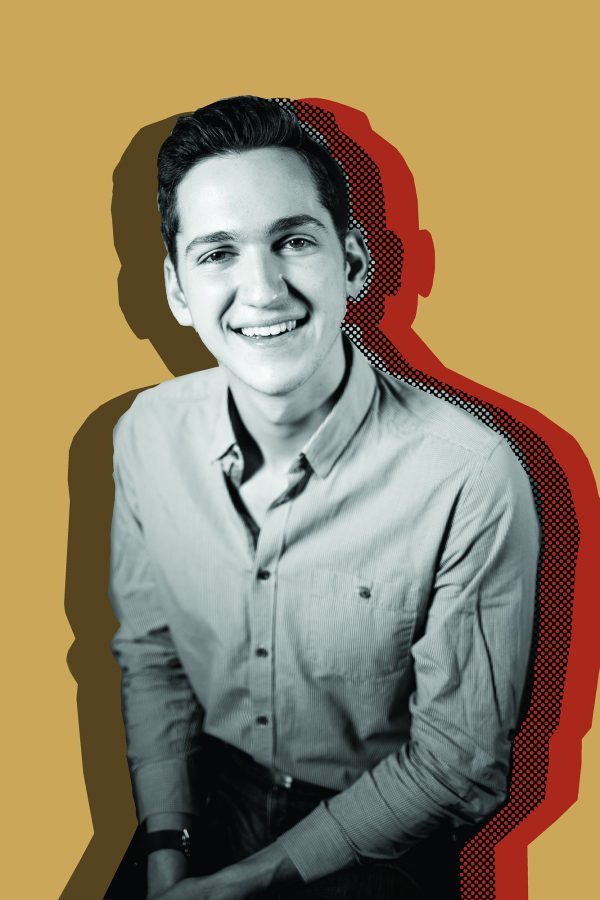
Never Himself
By Pamela Jew, Under the Arch Managing Editor
Matthew Friend spends a majority of his day not in his own voice. You might sing in the shower. Well, Friend talks as Rami Malek, Timothée Chalamet, Marge Simpson and a couple hundred more. He can sing, too, but in the voice of Michael Bublé. Cue the Michael Bublé taking a shower impression.
A stranger neither to city life nor the comedy scene, the Chicago native only transferred to NYU last spring from Tufts University in Massachusetts, where he studied Political Science and Theater. Friend decided to transfer after realizing he could further his comedy career in New York City. As a Gallatin junior, his concentration focuses on political satire, comedy, acting and entertainment business, but he does most of his impression training outside of the classroom. Currently, he’s a production intern at “The Tonight Show Starring Jimmy Fallon” and performs multiple times a month at local comedy clubs. (He books them all himself; he says one day he’ll have “people.”) But his end goal, as of now, is being a repertory player on “Saturday Night Live.”
His impressions emulate his admiration. If comedy is Friend’s religion, then “Saturday Night Live” is the service. (His Instagram handle, @matturdaynightlive, riffs on the show’s title.) Every Saturday night, if Friend isn’t going out with friends, he’s in his room watching “SNL” — his version of studying — and talking to himself in a mirror.
No matter what stage he’s in while perfecting an impression, he’ll post it to his Twitter, YouTube channel or Instagram. His Instagram page is filled with a series of freeze-frame images of Friend mid-impression. When you click on one, for example, Roger Federer, Bernie Sanders or Sebastian Maniscalco will speak but with the face of Friend. His videos have even caught the attention of Armie Hammer on Twitter and Bobby Moynihan, who saw Friend outside the “SNL” stage door and recognized him.
“It was so cool,” Friend beamed. “[Moynihan] was like, ‘You’re that kid from Twitter, right?’”
To date, he has about 250 impressions he can do, which he tracks with a list on his phone, from Ronald Reagan to Coach Steve from “Big Mouth.” He even does impressions of impressions, specifically of celebrities playing President Donald Trump — Alec Baldwin, Stephen Colbert and Jimmy Fallon.
“I just watch these people a lot. I just spend an inordinate amount of time just talking like them,” Friend said. “It’s an obsessive thing. You can’t just make someone have that quality. I just started doing it when I was 4. Like that guy, I think he sounds funny. I want to talk like that guy.”

When Friend was 4 years old, his parents were having a party, but, as always, Friend’s behavior got out of hand. His father sent him away from the party where he found the portal to his impression addiction — Austin Powers. The DVD was sitting out on a bookshelf; attracted to the psychedelic cover, Friend put it on the TV and the rest is history.
“I would go around to my parents’ friends and I would go up to random family members and say, ‘Do I make you randy?’” he said, impersonating Powers. “I had no idea what it meant.”
As a kid, Friend had featured performances at all of his family gatherings. For his grandparents, he’d do Johnny Cash or Ed Sullivan, whom he considers one of his comedic inspirations. At his high school talent show, he impersonated the principal, who sat in the back of the auditorium and later patted him on the back for what Friend recalls as “a spot-on performance.” At NYU, he was recently the featured performer for “Views from NYU,” a semesterly live-studio audience talk show.
The second time we met, I challenged him to not do any impressions. He broke in less than five minutes. He shuffled through seven — Barack Obama, Brett Kavanaugh, David Beckham, Shawn Mendes, Bradley Cooper, Sacha Baron Cohen, Ricky Gervais — before realizing he had broken the rules. In his stand-up routines and even when we talked, he defaults to Stewie from “Family Guy.” Maybe he hasn’t learned a better transition, or maybe it’s just easier to have someone else do it for him — I’m still not sure.
Even when Friend does talk in his own voice, it sounds like he’s doing a bit. Prepubescent boys envy his low register. Hell, full-grown men might, too. It just makes his impressions all the more jarring as he seamlessly phases in and out. But what really alarms audiences is his Barack Obama impression — or rather his three Barack Obama impressions.
I watched and heard a packed audience at Gotham Comedy Club in Chelsea knock back in their chairs, gasping, as Friend shuffled through his Obama impressions — Obama giving a speech, Obama speaking to children and Obama hanging out with the boys. His set was surrounded by other comedians, whose material focused on their dry dating lives, casual interactions with women and the joys of sex without a condom. The audience was about half women and met those jokes with silence and diverted eyes.

Later, I told him his jokes and impressions brought real humor among other borderline #MeToo acts. Friend says he keeps his set pretty clean unless the impression calls for it. (He saves the dirty stuff for his friends and family.) Only recently has Friend started writing his own jokes, in addition to his impressions — he’s a performer over anything else.
But as any performer can tell you, making it in show business isn’t easy stuff. I had my suspicions; Friend had his confidence.
“Do you have any doubts about making it in comedy?”
“No. No, I’m 20. Why would I?”
As someone older than Friend by a few months, I had all the reason in the world to have doubts at 20. But I’m not a 6-foot-4-inch white guy — yes, I had to go there — from Chicago proper with a nuclear family, each member laden with successes of their own: his dad works in investment management, his mom owns an Instagram-famous cookie business, his brother endures long hours at J.P. Morgan and his sister edits for Food & Wine magazine.
I spent most of our interviews trying to crack what is seemingly the scratch-free life of Matthew Friend. I grew up in the suburbs of Georgia, taking dance classes at a local studio. He grew up in Lincoln Park, taking acting classes at Second City as a kid. I have one parent, no siblings. He has what he calls “the most supportive family you could have.” Our upbringings were starkly different, and I couldn’t contextualize his luck thus far. I asked him how life might be different if Second City weren’t mere steps away. He quipped back, “How can I imagine a hypothetical life I was never subject to living?”
He calls his life progression so far pure luck. The worst time in his life? When he had a severe gluten allergy diagnosed at 9 months old. But in the eighth grade, after flying out to an allergen specialist at Stanford Hospital in Palo Alto, California every two weeks with both his parents to build up his gluten tolerance, his allergy diminished. Now, he can eat a few slices of pizza with no problem, and his mom can safely bring home her company’s cookies. He makes jokes about it now, referring to himself as that “weird kid with the gluten allergy.”
When I questioned him about his personal life, I was met with some resistance. “What does that have to do with the profile?” In a rare moment of our conversation, I explained what a profile is and why I was asking personal questions — without him quickly cutting in — as he furrowed his brows. I told him he seemed closed off — he didn’t want to tell me what he did the Saturday night before when I tried to make small talk. (He watched “SNL.”) His 15-minute set told me more about him than the few times we met one-on-one. But he assured me that he was as “open as any guy could be.”
So I cut to the question hanging in the back of my head. “Are you, like other comedians, using comedy to cope with something greater?”
“I’m not using comedy to cope with anything,” he asserted. “That’s not to say it doesn’t help others in that way.”
My bare-bones knowledge of comedy — my preferred genre is YouTube comedy — rivaled his understanding of what a fleshed out profile is. During our first meeting, I politely pretended to know every comedian he named. I even faked a laugh at his “House of Cards” Frank Underwood (Kevin Spacey) impression — something Friend even says isn’t as funny post-scandal.
He taught me about comedy and impressions — knowledge he takes great pride in. If I didn’t know the comedian, he’d slip into their voice and seat me front row. Every time I met him, I also met 20 or so other people that came out of his mouth.
If you don’t know Friend on a personal level, it’s hard to consume more than just a Netflix comedy special’s worth of him. He’s joke after joke after joke.
At this issue’s photo shoot, he made us all laugh for the mere 40 minutes he was there. We subsequently let out an exhausted breath as the door shut behind him. He makes himself the center of attention and tries to draw your mind from any anxieties you might have at the moment. That’s his whole purpose in this.
“[Comedy] is a way of helping others to relieve stress and put a smile on someone’s face which I do think makes a difference in such a tumultuous world and environment that we live in,” Friend said. “There are immense benefits to being able to make someone laugh and ease people’s anxieties.”
His eyes are set on “SNL,” which has caught heat recently for some of its material — such as Pete Davidson’s impression of Lieutenant Commander Dan Crenshaw and Alec Baldwin’s famous Trump impression. I questioned the longevity of the show itself. Friend says we need comedy and mediums like “SNL.”
“People notoriously laugh at portrayals of themselves,” Friend said. “Dana Carvey was famously friends with George H.W. Bush. And [Bush] invited him to the White House to do his impression of him. If you make the argument that this impression is more mean-spirited than Alec Baldwin[‘s Trump impression], then again right now the president is more mean-spirited. So no, we need shows like this. I hope to take part in it one day.”
Email Pamela Jew at [email protected]. A version of this article appears in the Thursday, March 14, 2019, print edition on Pages 18 and 19. Read more from Washington Square News’ “Up-and-Comers 2019.”






















































































































































